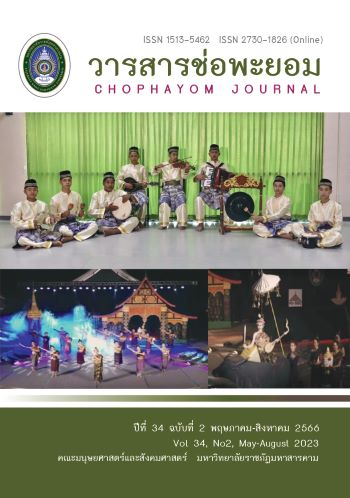Verbal and Non-Verbal Pragmatic Communication Patterns for Thai Homestay Staff
Keywords:
Verbal communication, Non-verbal communication, Pragmatic communication patterns, Thai Homestay staffAbstract
The study aimed to explore the verbal and non-verbal pragmatic communication of Thai homestay staff when interacting with foreigners. The goal was to develop patterns for both verbal and non-verbal pragmatic communication. Tools used for data collection included questionnaires and semi-structured interviews. Average mean score, standard deviation and content analysis were deployed to narrate the qualitative data. The findings revealed that six common English pragmatic communication patterns were used by homestay owners and staff verbally and non-verbally. Homestay owners and staff’s pragmatic communication pattern followed communication functions; nevertheless, the pragmatic competence of homestay was aware solely of politeness via non-verbal communication, for example, body gestures, signs, and other media. Regarding the suggested pragmatic communication expressions, several competencies were developed and acknowledge based on communication functions, Grice’s cooperative of maxims, and principles of politeness. However, non-verbal communication was offered among language formats to reemphasize the meaning of verbal communication, fix misunderstandings and uncompleted messages, and maintain the politeness of speech acts. Keywords: Verbal communication, Non-verbal communication, Pragmatic communication patterns, Thai Homestay staff
References
Anata, H. & Nuraini, K. (2019). Teacher Communication Pattern in English Learning Process as Foreign Language in Senior High School. Advances in Social Science, Education and Humanities Research, 349, 204–208. Retrieved 20 March, 2023, from https://www.atlantispress.com/article/125919057.pdf.
Betti, J. M. (2021). Grice’s Maxims. Retrieved 20 May, 2023, from https://www.researchgate.net/publication/354554834_Grice's_Maxims.
Chan, K.K.S. and Mak. W. S. (2012). Shared decision making in the recovery of people with schizophrenia: The role of metacognitive capacities in insight and pragmatic language use. Clinical Psychology review. Retrieved 15 April, 2023, from https://www.sciencedirect.com/topics/psychology/cooperative-principle.
Choraih, M. A., Loutfi, A., & Mansoor, A. (2016). The Importance of Pragmatic Competence in the EFL Curriculum: Application and Implications*. Retrieved May, 2023, from https://www.researchgate.net/publication/318001145_The_Importance_of_Pragmatic_Competence_in_the_EFL_Curriculum_Application_and_Implications.
Cruz, M. P. (2009). Review of Pragmatics and Non-verbal Communication. Retrieved 2 June, 2023, from https://www.researchgate.net/publication/264323185_Review_of_Pragmatics_and_Non_verbal_Communication_by_Tim_Wharton.
Deda, N. (2013). The role of Pragmatics in English Language Teaching. Pragmatic Competence. Retrieved 15 April, 2023, form https://www.richtmann.org/journal/index.php/ajis/article/view/106.
Daoust, C. (2021). The importance of customer service in the hospitality industry. Retrieved June, 2023, from https://hotello.com/en/customer-service-hotels/.
Eslami, Z. R. (2013). Teaching and Learning Pragmatics: Where Language and Culture Meet. Pragmatics and Society. Cambridge University Press. USA. pp. 7-24.
Helenko, N. & Wang, J. (2022). Pragmatics in English language learning. Cambridge: Cambridge University Press.
Jaroensak, T. (2018). ELF on a tropical island: The use of pragmatic strategies in touristic ELF in Thailand. Retrieved April, 2023, from https://core.ac.uk/download/pdf/211024017.pdf.
Kappina, K., Charoennaiwongphao, W., & Konchiab, S. (2021). Needs for Improving Non-Verbal Communication Skills of Thai Homestay Staff in the New Normal Tourism Context, Chiang Mai. FEU Academic Journal, 15(1), 80–99.
Meunchong, W. (2023). English for Homestay Tourism: Barriers and Needs of Entrepreneurs in Rural Community of Thailand. Retrieved 8 July, 2023, from https://tpls.academypublication.com/index.php/tpls/article/view/5484.
Skill success. (2019). English Conversation Patterns for Efficient Communication. Retrieved 9 July, 2023, from https://blog.skillsuccess.com/english-conversation-patterns-forefficient-communication/.
Sigmund G. (2020). Social science research methods: Social research methods:qualitative, quantitative and mixed methods approach. Los Angeles, Sage, 582p.
Susanti, N, Lalifa, I. & Sunarsi, D. (2020). The Effects of Profitability, Leverage, and Liquidity on Financial Distress on Retail Companies Listed on Indonesian Stock Exchange. Jurnal Ilmiah Ilmu Administrasi Publik. 10. 45. 10.26858/jiap. v10i1.13568.
University of Minnesota. (2016). Communication in the Real World: An Introduction to Communication Studies. Retrieved June, 2023, from https://doi.org/10.24926/8668.0401.
WordPress. (2012). Verbal and Non-verbal Communication Patterns. Retrieved 3 June, 2023, from https://kkunz11.wordpress.com/2012/12/06/verbal-and-non-verbalcommunication-patterns/.
Downloads
Published
How to Cite
Issue
Section
License
Copyright (c) 2023 Chophayom Journal

This work is licensed under a Creative Commons Attribution-NonCommercial-NoDerivatives 4.0 International License.






